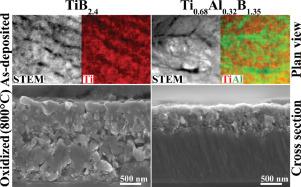当前位置:
X-MOL 学术
›
Acta Mater.
›
论文详情
Our official English website, www.x-mol.net, welcomes your feedback! (Note: you will need to create a separate account there.)
Improving the High-temperature Oxidation Resistance of TiB2 Thin Films by Alloying with Al
Acta Materialia ( IF 9.4 ) Pub Date : 2020-09-01 , DOI: 10.1016/j.actamat.2020.07.025 Babak Bakhit , Justinas Palisaitis , Jimmy Thörnberg , Johanna Rosen , Per O.Å. Persson , Lars Hultman , Ivan Petrov , J.E. Greene , Grzegorz Greczynski
Acta Materialia ( IF 9.4 ) Pub Date : 2020-09-01 , DOI: 10.1016/j.actamat.2020.07.025 Babak Bakhit , Justinas Palisaitis , Jimmy Thörnberg , Johanna Rosen , Per O.Å. Persson , Lars Hultman , Ivan Petrov , J.E. Greene , Grzegorz Greczynski

|
Abstract Refractory transition-metal diborides (TMB2) are candidates for extreme environments due to melting points above 3000 °C, excellent hardness, good chemical stability, and thermal and electrical conductivity. However, they typically suffer from rapid high-temperature oxidation. Here, we study the effect of Al addition on the oxidation properties of sputter-deposited TiB2-rich Ti1-xAlxBy thin films and demonstrate that alloying the films with Al significantly increases the oxidation resistance with a slight decrease in hardness. TiB2.4 layers are deposited by dc magnetron sputtering (DCMS) from a TiB2 target, while Ti1-xAlxBy alloy films are grown by hybrid high-power impulse and dc magnetron co-sputtering (Al-HiPIMS/TiB2-DCMS). All as-deposited films exhibit columnar structure. The column boundaries of TiB2.4 are B-rich, while Ti0.68Al0.32B1.35 alloys have Ti-rich columns surrounded by a Ti1-xAlxBy tissue phase which is predominantly Al rich. Air-annealing TiB2.4 at temperatures above 500 °C leads to the formation of oxide scales that do not contain B and mostly consist of a rutile-TiO2 (s) phase. The resulting oxidation products are highly porous due to the evaporation of B2O3 (g) phase as well as the coarsening of TiO2 crystallites. This poor oxidation resistance is significantly improved by alloying with Al. While air-annealing at 800 °C for 0.5 h results in the formation of an ~1900-nm oxide scale on TiB2.4, the thickness of the scale formed on the Ti0.68Al0.32B1.35 alloys is ~470 nm. The enhanced oxidation resistance is attributed to the formation of a dense, protective Al-containing oxide scale that considerably decreases the oxygen diffusion rate by suppressing the oxide-crystallites coarsening.
中文翻译:

与Al合金化提高TiB2薄膜的高温抗氧化性
摘要 难熔过渡金属二硼化物 (TMB2) 熔点高于 3000 °C,具有优异的硬度、良好的化学稳定性以及导热性和导电性,是极端环境的候选材料。然而,它们通常会遭受快速高温氧化。在这里,我们研究了 Al 添加对溅射沉积的富含 TiB2 的 Ti1-xAlxBy 薄膜的氧化性能的影响,并证明将 Al 合金化薄膜显着提高了抗氧化性,但硬度略有下降。TiB2.4 层通过直流磁控溅射 (DCMS) 从 TiB2 靶上沉积,而 Ti1-xAlxBy 合金薄膜通过混合高功率脉冲和直流磁控共溅射 (Al-HiPIMS/TiB2-DCMS) 生长。所有沉积的薄膜都表现出柱状结构。TiB2.4 的柱边界富含 B,而 Ti0.68Al0. 32B1.35 合金具有富钛柱,被主要为富铝的 Ti1-xAlxBy 组织相包围。在高于 500 °C 的温度下对 TiB2.4 进行空气退火会导致形成不含 B 且主要由金红石-TiO2 (s) 相组成的氧化皮。由于 B2O3 (g) 相的蒸发以及 TiO2 晶粒的粗化,生成的氧化产物是高度多孔的。这种较差的抗氧化性通过与铝合金化得到显着改善。虽然在 800 °C 下空气退火 0.5 小时会导致在 TiB2.4 上形成~1900 纳米的氧化皮,但在 Ti0.68Al0.32B1.35 合金上形成的氧化皮厚度为~470 纳米。增强的抗氧化性归因于形成致密、
更新日期:2020-09-01
中文翻译:

与Al合金化提高TiB2薄膜的高温抗氧化性
摘要 难熔过渡金属二硼化物 (TMB2) 熔点高于 3000 °C,具有优异的硬度、良好的化学稳定性以及导热性和导电性,是极端环境的候选材料。然而,它们通常会遭受快速高温氧化。在这里,我们研究了 Al 添加对溅射沉积的富含 TiB2 的 Ti1-xAlxBy 薄膜的氧化性能的影响,并证明将 Al 合金化薄膜显着提高了抗氧化性,但硬度略有下降。TiB2.4 层通过直流磁控溅射 (DCMS) 从 TiB2 靶上沉积,而 Ti1-xAlxBy 合金薄膜通过混合高功率脉冲和直流磁控共溅射 (Al-HiPIMS/TiB2-DCMS) 生长。所有沉积的薄膜都表现出柱状结构。TiB2.4 的柱边界富含 B,而 Ti0.68Al0. 32B1.35 合金具有富钛柱,被主要为富铝的 Ti1-xAlxBy 组织相包围。在高于 500 °C 的温度下对 TiB2.4 进行空气退火会导致形成不含 B 且主要由金红石-TiO2 (s) 相组成的氧化皮。由于 B2O3 (g) 相的蒸发以及 TiO2 晶粒的粗化,生成的氧化产物是高度多孔的。这种较差的抗氧化性通过与铝合金化得到显着改善。虽然在 800 °C 下空气退火 0.5 小时会导致在 TiB2.4 上形成~1900 纳米的氧化皮,但在 Ti0.68Al0.32B1.35 合金上形成的氧化皮厚度为~470 纳米。增强的抗氧化性归因于形成致密、


























 京公网安备 11010802027423号
京公网安备 11010802027423号